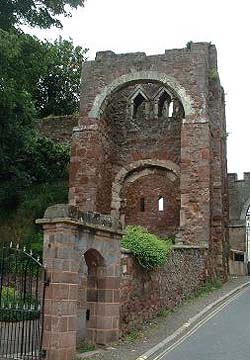TIMELINE: Exeter
by Darcy Lewis
 Ca. 50: Rome's Second Augustan legion arrives in southwest Britain and builds a wooden fort on a hill near the river Exe at its lowest crossing point.
Ca. 50: Rome's Second Augustan legion arrives in southwest Britain and builds a wooden fort on a hill near the river Exe at its lowest crossing point.
Ca. 75: The Legion abandons the fort. The Roman town of Isca Dumnoniorum is then built on the site.
Ca. 180-200: The Romans built a sturdy wall around the town.
Ca. 380: Faced with a waning population and destabilized money supply, Romans abandon the suburbs and gather within the town walls, even planting their crops inside.
Ca. 400: With Rome's departure from England, Isca Dumnoniorum ceases to function as a town.
680: The Saxons build a monastery inside the old Roman walls. Following their practice of dubbing former Roman towns a "caester," the new name "Exe caester" gradually morphs into "Exeter."
876: The Danes capture Exeter and spend the winter inside the walls.
894: The city withstands another Danish siege.
928: King Aethelstan order extensive repairs to the walls.
10th century: The Exeter Book is created. This comprises a quarter of all surviving poetry in Old English, including a famous series of riddles.
1001: The Danes unsuccessfully besiege the town again.
1003: Traitorous Hugh the Reeve lets the Danes into Exeter. The town is largely destroyed, then quickly rebuilt.
1050: The bishopric relocates to Exeter from Crediton.
1068: Exeter is at the center of a rebellion against William the Conqueror. The Normans lay siege to the town for 18 days but are unable to capture it. Eventually the people of Exeter agreed to submit to William in exchange for amnesty. He orders Rougemont Castle built within the town walls.
1087: St. Nicholas Priory is founded.
1114: Bishop William Warelwast, nephew of William, begins work on the Cathedral of St. Peter.
1140: Queen Matilda's baron Baldwin de Redvers holds Exeter against King Stephen for three months, capitulating only when water supplies ran out.
Ca. 1200: A network of underground passages is built to supply fresh spring water to the city.
Ca. 1200: The Exe Bridge, Exeter's first, is constructed.
Late 13th century: Isabella, Countess of Devon, builds a weir across the Exe, 3 miles south of Exeter. Ships can no longer sail into the town to load and unload their cargoes.
1330: The Guildhall in High Street is built. It is reputed to be the oldest municipal building still in full civic use in England.
1566: A canal is dug around the weir so ships could once again sail to the town.
1612: Northenhay Gardens are laid out; today, the gardens are the oldest public open space in England.
1643: A Royalist army lays siege to the town. Exeter holds out for three months.
1644: A Parliamentary army launches a siege. The Royalist defenders surrender six months later.
1681: The Customs House is built, one of the earliest brick buildings in Exeter.
1685: Alice Molland, the last person executed for witchcraft in England, is imprisoned in Exeter.
1707: Exeter's first newspaper launches.
1769: Exeter's first bank opens and the Assembly Rooms are built. North Gate is demolished to ease traffic flow.
1778: Exeter's main streets are paved and a new Exe bridge is built.
1784: East Gate is demolished.
1801: At the time of the first census, Exeter has a population of 20,000.
1815: West Gate and Water Gate are demolished.
1831: Henry Philpotts, later known as Henry of Exeter, was consecrated bishop. He becomes one of the most striking figures in the 19th-century Anglican Church.
1832: A cholera epidemic kills 440 people. Afterwards, a network of sewers was built.
1868: St. Michael's church is built.
1882: Horse-drawn trams begin to run in the streets.
1899: The famous 14th-century Exeter Puzzle Jug, which satirizes the medieval church, is discovered in fragments in South Street.
1905: Electric trams replace the horse drawn ones.
1931: The last tram runs in Exeter.
1937: Exeter's airport opens.
1942: The German Luftwaffe bombs Exeter in retaliation for RAF bombings of Lubeck and Rostock. Altogether 1,500 houses are destroyed and 2,700 are seriously damaged. Additionally, six churches are damaged or destroyed in the Exeter Blitz.
1950s: Much of Exeter's center city is rebuilt, though controversy erupts over whether some lightly damaged structures could have been saved.
1955: University of Exeter is founded.
1961: 'The House That Moved', a 14th century Tudor building, earns its name by being moved from its original location in order for a new road to be built in its place. Weighing more than 21 tons, it is strapped together and slowly moved a few inches at a time to its new home.
1967: Northcott Theatre is built.
1971: Archeologists discover remains of the Roman legionary fortress while digging in the Cathedral Close.
1977: Guildhall Shopping Centre opens. Harlequins Shopping Centre follows in 1986.
2005: Riddles from the Old English Exeter Book are inscribed on a highly polished steel obelisk placed in the high street.
Related Articles:
- Exeter - The Cathedral City, by Clayton Trapp
- https://www.timetravel-britain.com/articles/towns/exeter.shtml
- A Taste of Devon: Clotted Cream, Splits, Scrumpy and Gin, by Dawn Copeman
- https://www.timetravel-britain.com/articles/taste/taste06.shtml
Darcy Lewis is an award-winning freelance writer whose articles have appeared in Writer's Digest, HGTV Ideas, Home, and the Chicago Tribune, among many other publications. Much of Darcy's knowledge of British history can be traced to her work as a history major specializing in pre-modern England at Brown University in Providence, RI. But her passion has deeper roots: Darcy's English mother, who is an endless treasure trove of stories about "how we do things at Home."
Article © 2006 Darcy Lewis
Rougemont Castle Gatehouse, photo by Stephen Lea, courtesy of Wikipedia.org
| 